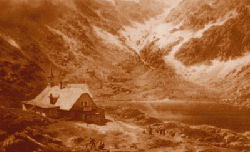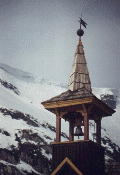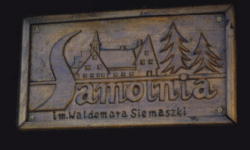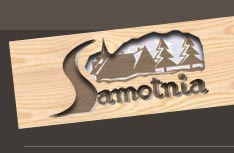 |
||||||||
|
||||||||
 History
The buildings that preceded the current Samotnia Refuge had been standing far before the arrival beside
the Small Pond (Mały Staw) of the present leaseholders, the Siemaszko family, in 1966, who have made the
place what it is today. Unfortunately, all of those constructions have been forgotten. For those who walk
the mountains the destruction of old refuges is similar to the passing away of an old wanderer V its charm
is lost, and hearts swell with the memories of times, customs and people never to return. Also lost to memory
are the old views of the Small Pond (Mały Staw), the silhouettes of the former owners and the old-fashioned
tourists dressed in pelerine, with puttees on their feet, huge bags on their backs and a flamboyant
enthusiasm in their hearts as they left on long tours to romantic mountain castles.
 The buildings once standing by the lake served for livestock farming and received the first swallows of the
tourist era in the Karkonosze Mts. The first 'tourists' began appearing in the 17th century, pilgrims
walking to the St. Laurent Chapel (Kaplica sw. Wawrzynca) located at the top of Mt. Lnieżka. They stayed
in farm cottages called 'bouda' by Czechs and 'baude' by Germans. Both words have survived to this day
and may easily be found on maps or in guidebooks to the Karkonosze Mts. At the turn of the 18th and 19th
century, bathers and patients at the health resort Cieplice Zdroj made hiking the mountains a bon ton
fashion. As time went by, hikers became more and more demanding, requiring more comfort, desiring
improvement in the conditions of a stay in the mountains. The function of farms switched from the
agricultural to the residential, these sites becoming mountain refuges offering board and lodging.
The buildings once standing by the lake served for livestock farming and received the first swallows of the
tourist era in the Karkonosze Mts. The first 'tourists' began appearing in the 17th century, pilgrims
walking to the St. Laurent Chapel (Kaplica sw. Wawrzynca) located at the top of Mt. Lnieżka. They stayed
in farm cottages called 'bouda' by Czechs and 'baude' by Germans. Both words have survived to this day
and may easily be found on maps or in guidebooks to the Karkonosze Mts. At the turn of the 18th and 19th
century, bathers and patients at the health resort Cieplice Zdroj made hiking the mountains a bon ton
fashion. As time went by, hikers became more and more demanding, requiring more comfort, desiring
improvement in the conditions of a stay in the mountains. The function of farms switched from the
agricultural to the residential, these sites becoming mountain refuges offering board and lodging.
Around 1800, the number of farm cottages was estimated at two and a half thousand. The German author of numerous publications about the Karkonosze Mts., Dr Hoser, found that the number of tourists at this time was no more than two thousand people in the summer months. At the same time the number of goats was twelve thousand, whilst the total number of cattle was twenty thousand. In the 19th century the number of hikers rose further and tours came to last more than one day. New tourists were forced to seek assistance at farm cottages. Farmers and shepherds saw new opportunities and began to offer all they possessed, that is, milk and cheese. Where the roads leading to the mountains were improved, farmers and shepherds provided bread, beer and vodka.  Tourists were proposed accommodation at provisional sheds
and, when these were full, tourists were lodged in lofts on hay or in extensions to the cottages. The
expert in the history and nature of the Karkonosze Mts., J.Ambroż, wrote in 1935, 'Accommodation in the
Karkonosze Mts. was very primitive in those days. People were sleeping on hay, the strong musty odour
penetrating clothing to the underwear, making sleep quite unpleasant. Guests either slept collectively
in the loft or downstairs in the rooms, on the floor without light. The worst aspect was climbing down
the ladder at night; there were neither good stairs nor
sanitary facilities. In the evening hikers sat in a smoky room, most often together with smugglers and
various suspected delinquents.'
Tourists were proposed accommodation at provisional sheds
and, when these were full, tourists were lodged in lofts on hay or in extensions to the cottages. The
expert in the history and nature of the Karkonosze Mts., J.Ambroż, wrote in 1935, 'Accommodation in the
Karkonosze Mts. was very primitive in those days. People were sleeping on hay, the strong musty odour
penetrating clothing to the underwear, making sleep quite unpleasant. Guests either slept collectively
in the loft or downstairs in the rooms, on the floor without light. The worst aspect was climbing down
the ladder at night; there were neither good stairs nor
sanitary facilities. In the evening hikers sat in a smoky room, most often together with smugglers and
various suspected delinquents.'
Momentous dates: From written records it seems certain that the first construction by the Small Pond (Maly Staw) was standing before 1670. 1670 - the first man to write about the old cottage by the Small Pond was Chrystian Gryphius, the dean of the Magdalenaeum School in Wroclaw. Describing his tour to the Karkonosze Mts. on September 7, 1670 he stated 'When we had reached the Small Pond we met an elderly man aged 65. This old man was brought up in the mountains and did not want to go down as he claimed that he disliked the air in the valley. When I asked him what he ate, he showed me a herd of goats climbing the rocks. In winter he nailed wooden beams to the doors and when he had to walk on the snow he put on snowshoes (Translator's note: 17th-century snowshoes were made of branches of the dwarf mountain pine and were tied to boots; they were called 'karple').' At the end he added, 'This old man led us through the wet meadow until finally we reached the old cottage where the horses had been waiting for us'. A few years later a court official named Teodor Billewicz left a very demonic description of this spot and claimed that he saw a boat drifting on the pond. September 24, 1712 - in the town of Cieplice lšskie, in the Church Records, a secret counsellor named Seidel found the information that 'Georg Schoder, the son of Mateus, a farmer by the Small Pond near Mt. nieżka, died in 1710'. This was probably the son of the first guardian of the Pond who watched over the trout belonging to the owner of the Pond, that is, the von Schaffgotch family. No information then appears for over 100 years.  1821 - in the engraving of a painter from the town of Kowary, named Friedrich Tittle, a old cottage by the Small Pond was standing in a different place to the present refuge. It was located higher and more to the north.
1821 - in the engraving of a painter from the town of Kowary, named Friedrich Tittle, a old cottage by the Small Pond was standing in a different place to the present refuge. It was located higher and more to the north.1831 - important evidence pertaining to the cottage by the Small Pond may be found in a painting created by Ludwig Richter, whose works may be seen in Poland, Germany and the USA. The painting shows a man beside the Pond and a cottage, carrying a huge bundle on his back and leading a child by the hand and a dog. Following labourious research, it appeared that the boy seen in the painting was the penultimate host of the refuge, Karl Häring, who was being led by his father in 1831. Karl Häring was carried on his father's back across the mountains from the town pindleruv Mlýn, on the Czech side, where Karl was born. February 7, 1737 - a physician from the town of Jelenia Gora named K. G. Linder left an interesting description of the Small Pond. He published his impressions from a winter tour to the mountains and recalled the falling of a huge avalanche on the pond: 'The daughter of the watchman led us to the base of the avalanche, which looking terrifying and wild. While the avalanche fell a tremendous roar resounded, the watchman's cottage trembled to its foundations and all the window-panes cracked. People thought it was an earthquake and lost their hearing completely for some time. The ice on the pond, which has a thickness of 2m, was entirely broken and scattered about. Chunks of ice were everywhere. Water overflowed the banks of the pond, and people living in the area presumed that there was no water left in the pond at all, but that it was filled with snow instead. The trout were lying dead, suffocated, which was a real loss.' Interesting information was provided by B. Lessenthin in his book 'The Karkonosze Mts. in Winter'. He claims that the cottage by the Small Pond was built around 1654, just after the construction of another cottage on the meadow called Złotówka, which is now known as the Strzecha Akademicka Refuge. 1844 the poet Bogusz Zygmunt Stęczyński took a long journey throughout the whole of Lower Silesia and visited the Karkonosze Mts. He also wrote a poem titled 'Silesia'. Here is how he described the surroundings of both the Small and Great Ponds: Walking over the silvery ridge We stop filled with astonishment. The Great Pond is sparkling amongst the altar of rocks, It simpers with its distance, it horrifies in its nearness, At the foot a second appears, Only deeper, sadder, without the decor of nature, Because it has necked mountains around, And the blenched hue of huge stones, Fallen by the force of time, they lie immortal. There is a cottage in summer inhabited by shepherds, By tired guests visited sometimes, In which fire is lit with a rumble, Shepherds sleeping lie one by the other... [Polish-English translation by: Blanka Myszkowska] 1872 - the building was dismantled by the then owner Häring in 1872; an old document states, 'the old wood of which it was made became touchwood'. 1883 - the next building by the Small Pond was built, more to the north and closer to the pond, at a distance of 40m from the shore, i.e. in the present location. 1891 - Heinrich Richter from the village of Miłków bought a cottage for 4,000 thalers. He constructed two bedrooms in the attic and furnished them. It is from this period that the icon of the present Samotnia Refuge dates - the turret and the bell cast in Jelenia Góra. It is supposed that H. Richter possessed the bell before he arrived at the Pond. The cottage became a mountain refuge and its function changed from fish breeding to accommodation. Richter also built the 2.5m wide road for horse-drawn carriages. The previous owner, Karl Häring, died at the age of 70 in 1897. In his building, 11 children were born - three boys and eight girls. 1890 among the many authors describing the area of the Small Pond, Edward Petrak should be mentioned, an expert from the Karkonosze Mountain Society in Austria. Staying in the Karkonosze, he visited the small Pond and claimed, 'The watchman dealt with the fish breeding, in winter breaking air holes in the ice.' Being enchanted by the views he wrote, 'The view of the Pond and its surroundings seen from the refuge belongs with the most outstanding of natural miracles that mountains can offer.' After 1900, for several years, the refuge was leased by Joseph Bönsch; later Richter sold it to F. Krause, who modernized it. 1913 - in the early 20th century, when F. Krauss was the owner of the refuge, an incredible message appeared in the Silesian newspaper which moved lovers of the mountains. Thirty years earlier, the owner of the cottage had tried to sell the lot by the Pond for 150,000 marks. It was also confirmed by the contract that the refuge could have been replaced by a huge inn with a colony of houses. Fortunately, thanks to the members of the Karkonosze Mountain Society in Austria this potentially regrettable project was abandoned. The local administration decided in 1913 to ban entirely any changes in the development of the land and buildings by the Small Pond. 1922-23 - the refuge was expanded and developed. In the pages of the German magazine 'The Wanderer', the following note could be read: 'The refuge was significantly enlarged and opened festively for tourists on July 17, 1923.' On one stone a few metres from the present refuge in the direction of the Strzecha Akademicka Refuge is the inscription 'Erbaut Herr Franz Krauss 1922', which probably commemorates the commencement of construction. 1934 - the last extension of the refuge took place in 1934 when the northern wing was added and, thanks to this, capacity increased. The whole body of the refuge was shaped then into its current form. This occurred when the refuge was managed by the Hasse family. In 1937 the refuge was managed by the widow Margareta Hasse, who probably stayed there until 1945. In the 1930s, she employed seven people: a barmaid, kitchen hand, servant, carriage man and three waitresses. After 1945, the country passed to Poland and Silesia became a part of the so-called Recovered Territories. Poles and exiles arrived from eastern Poland and Ukraine (after 1945, the Soviet Union), the German inhabitants moving west in turn. 1945-1950 - after the Second World War, the refuge was taken over by the first Polish tenant, Stanisław Staroń from Cracow. In 1950 the refuge became the property of the Polish Country Lovers' Association (PTTK). The refuge had changed hands many times, which was sadly clear to see in its technical condition. This outline shows that our refuge is one the oldest human settlements in these mountains. The refuge is under special protection and is regarded in Polish law as an architectural monument. The Era of Waldemar Siemaszko (1931-1994) In 1966, Waldemar Siemaszko was nominated the leaseholder of Samotnia Refuge and became the site's good ghost and vivid legend. Together with his wife Sylwia he created an incomparable atmosphere and modernized the refuge to make it one of the most visited tourist spots in Poland. The first biological sewage-treatment plant in the Sudety Mts. was built here, the heating system was transformed from coke-burning to oil-burning, one of the rooms was adapted for the self-service ski storage room, the first garage for the Canadian snowmobile was built and the kitchen and washroom were refurbished. New concepts were planned, but in 1975 a capital overhaul was declared uneconomic. The refuge continues to serve the tourist to this today, although some had the idea of turning it into a museum. It also appeared necessary to shore up the ceiling of the restaurant and main staircase. The refuge had a party of devoted lovers granted a special title and the badge 'Meritorious for the Refuge', with help of whom mountain film festivals and slide shows were organised. Diving competitions for the Blue Ribbon of the Samotnia Refuge took place in the waters of the Small Pond. However, nature conservation criteria forced both participants and hosts to cease, although the divers were in fact cleaning the bottom of the pond. Before the foundation of the Karkonosze National Park in 1959, the Slalom Gully (leb Slalomowy) was full of skiers. On the second day of Easter the 'Spring Slalom' was organised. The 'Chocolate Slalom' had a fun character, chocolate owing both to the tanning of skin in the spring sun and the hue of the mud where some skiers landed. Since 1967, the 'Samotnia Cup' ski competition has been organised both in the slalom and giant slalom. The main initiator, W. Simaszko, together with friends and lovers of skiing set out the regulations. The most tragic day came on February 10, 1994. Close to the curve by the Wang Stave Church, on an unprotected and icy road, a car fell from the scarp. The sole casualty was Waldemar Siemaszko, who died of the irresponsible behaviour of a tourist on the trail and the attentions of an unprofessional physician unable to give proper first aid. Based on the writings of Marek K.Wikorejczyk and Waldemar Siemaszko.
"SAMOTNIA"
nad Małym Stawem im. Waldemara Siemaszki |
||||||||






